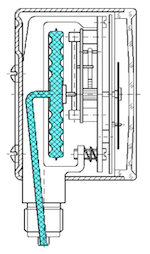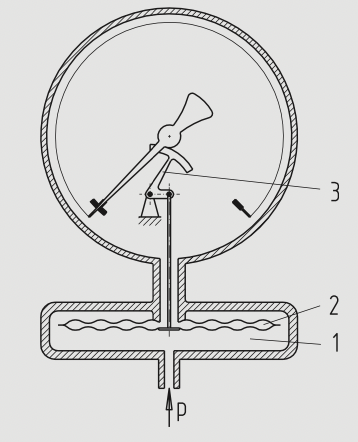
To accurately measure pressure below 10 psi (690 mbar), mechanical gauges use a capsule element. Capsule gauges are found in applications that operate in a vacuum or pressures as low as 1″ water column.
In most Bourdon tube pressure gauges, the range limitation on the lower end is 10 psi (690 mbar). Measurements below that call for a different sensing element. A low pressure gauge with a capsule design can go down as low as 1″ H2O (0.036 psi, 2.5 mbar), and measures positive and negative gauge pressure. Capsule elements are also used in other product families, such as differential pressure gauges.
How does a low pressure gauge work?

Figure 1: gauge with vertical capsule element
Low pressure gauges have a very sensitive mechanism consisting of two corrugated discs, each made of brass or stainless steel, that are fused together to create a circular capsule. The slightest changes in pressure cause the capsule to expand or contract; a pinion movement mechanism transfers this motion to the indicator.

Figure 2: gauge with perpendicular capsule element
Capsule gauges are cost-effective instruments that measure low pressures very precisely and with accuracies up to ±1.0% of span. The accuracy varies according to the gauge’s nominal size. This is because the capsule element is typically placed vertically inside the case, parallel with the dial face (Figure 1). The larger the disc surface area, the better it is able to detect low pressure changes.
For low pressure gauges with high overpressure safety, the capsule sits perpendicular below the case (Figure 2). As pressure (p) enters the pressure-sealed measuring chamber (1), it deflects the capsule measuring element (2), which transmits the motion to the movement (3) and indicator. The capsule element is supported by the surrounding housing and, therefore, can achieve high overpressure ratings. This design can be found in model 632.51 (4″ or 6″), and it comes standard with an overpressure safety of 50 times of full scale.
Applications for low pressure gauges
Capsule gauges are found in applications that operate in a vacuum or very low pressures. These include, but are not limited to, the following:
• Fan and blower monitoring
• Filter monitoring
• Low-pressure pneumatic systems
• Vacuum pumps
• Medical suction devices
• Gas burners
• Overpressure monitoring in clean rooms
Low pressure gauges are used in a variety of industries:
• Medical equipment
• HVAC
• Oil and gas
• Petrochemical
• Power generation
• Environmental technology
• Mechanical engineering
A low pressure capsule gauge with brass wetted parts is suitable for most applications. For use with aggressive media, choose a stainless steel pressure gauge.
Important note: Low-pressure capsule gauges can be used only for dry gaseous media. Due to the instrument’s vertical position and the very narrow passage into the capsule element, liquid media won’t be able to drain out completely. Any liquid that remains inside the capsule will create a hydrostatic load, which will result in a false pressure indication. To measure liquid media at very low pressures, use a Sealgauge diaphragm pressure gauge like the 43X.30, 43X.36, or 45X.50.
Benefits of using WIKA low pressure gauges
Because low pressure gauges can be used in a variety of industries, the benefits are equally diverse. Here are some reasons for choosing a WIKA capsule gauge:
- A standard capsule pressure gauge is optionally available with increased overpressure or underpressure safety – up to 10 times the full scale, depending on the range. A special integrated relieve valve is activated in positive or negative overpressure situations, protecting the capsule element.
- Unlike with a Bourdon tube pressure gauge, the pointer of a capsule gauge can travel clockwise when measuring vacuum. A clockwise pointer travel under vacuum is a standard, especially in the medical industry. In these cases, the dial face will indicate “VACUUM” to avoid any confusions.
- Our low pressure gauges come standard with an external zero adjustment screw, as certain operating conditions could cause the very sensitive capsule element to shift from zero.
- For extra precision and repeatable accuracy, Swiss movement is standard on our low pressure gauges. The pinion gear and shaft of the movement are made of finely polished nickel-silver.
- We offer non-magnetic versions for use in certain applications, such as when the pressure gauge is part of a medical device that stays with the patient during MRI procedures.
WIKA manufactures many models of low pressure gauges with a variety of wetted materials, scale ranges, accuracies, nominal sizes, and safety options. To find the appropriate instrument for your low-pressure application, contact the technical specialists at WIKA USA.
• Sealgauge® diaphragm pressure gauges 43X.30, 43X.36, and 45X.50


I am looking for a vaccum measuring setup with least count of 0.1 mbar
Hello Aniket, thank you for your inquiry. Your request has been passed along to info@wika.co.in and you should be hearing from them shortly. If your request is urgent, feel free to email info@wika.co.in again.